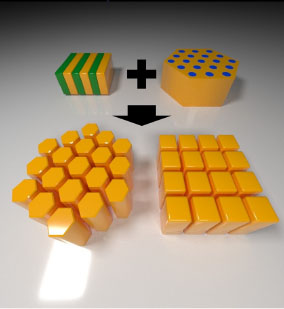| Jun 28, 2023 | |
Next-generation memory storage with novel block copolymer structures |
|
| (Nanowerk Spotlight) Block copolymers – plastics capable of forming a variety of minuscule, structured patterns – are generating significant interest in the scientific community. With potential applications in next-generation computer chips, filters, and optical devices, the potential of these materials seems promising. This promise hinges largely on the arrangement and proportion of each polymer type or building block within the block copolymer. | |
| A new study, published in ACS Macro Letters ("Tetragonally Packed Inverted Cylindrical Microdomains from Binary Block Copolymer Blends with Enhanced Hydrogen Bonding"), has now uncovered a novel method to form a high-density square pattern of these structures, paving the way for potential breakthroughs in high-density memory storage devices. | |
| "Our findings are centered around a novel nanostructure, the 'tetragonally packed inverted cylinders', that we achieved by blending two block copolymers," Jin Kon Kim, a professor at Pohang University of Science and Technology and Director of the National Creativity Research Initiative Program for Smart Block Copolymers in Korea, who led the study, tells Nanowerk. "The 'inverted' in the name refers to a major component becoming the cylinder in the minor component matrix, an unusual characteristic given that conventionally, it's the minor component that forms the cylinder." | |
 |
|
| Inverted cylinders with hexagon (bottom left) and square (bottom right) cross-sections by blending of conventional lamellae (top left) and cylinders (top right). (Image: Prof. Kim, POSTECH) | |
| These cylindrical nanostructures have been utilized in a variety of applications, but certain limitations, such as a large distance between neighboring cylinders due to a lower volume fraction, have been roadblocks to creating high-density nanopatterns. The hexagonal packing of cylinders is also not suitable for device processing compared to tetragonal packing. | |
| Addressing these challenges, the research team sucessfully fabricated inverted cylindrical nanostructures with a large volume fraction and tetragonal packing. | |
| "In a conventional cylindrical microdomain, a minor component with a volume fraction less than 0.35 becomes a cylinder in the majority component matrix," Kim explains. "However, in an inverted cylindrical microdomain, a major component having a volume fraction larger than 0.5 becomes a cylinder in the minor component matrix." | |
| This innovation in the formation of cylinders is especially critical for the production of high-density arrays, which are instrumental in creating the next generation of memory devices. | |
| "Traditionally, when we use block copolymers to produce cylindrical nanostructures, the volume fraction of cylinders is less than 0.35. This leads to a large distance between neighboring cylinders, hindering the creation of high-density nanopatterns," explains Kim. | |
| In simpler terms, imagine the cylinders as trees in a forest – the smaller the volume fraction (less than 0.35), the fewer trees (cylinders) there are, resulting in a more spread-out forest. This is why it's challenging to create closely-packed, or high-density, nanopatterns. | |
| Additionally, Kim notes, "The hexagonal packing of cylinders, a typical result with the lower volume fraction, isn't as efficient for device processing as the tetragonal or square packing." | |
| In this study, the team increased the volume fraction of cylinders to 0.7. This is like planting more trees in the forest—the greater number of trees (cylinders) allows them to be closer together, hence, achieving a high-density arrangement. This opens up more possibilities for creating densely packed nanopatterns, which are essential for developing ultra-compact memory storage devices. | |
| This is a notable breakthrough, as it pushes beyond conventional boundaries and offers the potential to develop ultra-high-density memory devices. However, achieving this ultra-high density pattern requires reducing the cylinder size, a feat that can be realized by using block copolymers with a very small molecular weight. But as Kim notes, "With decreasing molecular weight, two components in a block copolymer could not be microphase-separated to form a cylinder." | |
| The researchers believe this problem could be solved with a specific block copolymer where the two components show extremely high incompatibility. | |
| As for applications, these nanostructures can be transferred as ultra-high-density arrays of cylindrical nanopatterns on a substrate. These can then be used as templates for ultra-high-density arrays of nanodots, nano contacting holes. | |
| Looking forward, Kim sees the need for more diverse nanostructures and greater control of size in the field. "To widely utilize the self-assembled nanostructures, these developments could be realized by blending block copolymers with complex chain architecture and introducing a very strong attractive interaction between the blocks." | |
| Despite these challenges, the recent advancements and future potential of block copolymers in nanostructures and memory devices show a promising trajectory for this field of study. | |
 By
Michael
Berger
– Michael is author of three books by the Royal Society of Chemistry:
Nano-Society: Pushing the Boundaries of Technology,
Nanotechnology: The Future is Tiny, and
Nanoengineering: The Skills and Tools Making Technology Invisible
Copyright ©
Nanowerk LLC
By
Michael
Berger
– Michael is author of three books by the Royal Society of Chemistry:
Nano-Society: Pushing the Boundaries of Technology,
Nanotechnology: The Future is Tiny, and
Nanoengineering: The Skills and Tools Making Technology Invisible
Copyright ©
Nanowerk LLC
|
|
|
Become a Spotlight guest author! Join our large and growing group of guest contributors. Have you just published a scientific paper or have other exciting developments to share with the nanotechnology community? Here is how to publish on nanowerk.com. |
|
